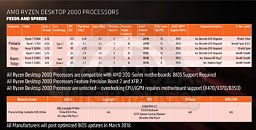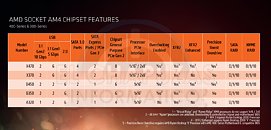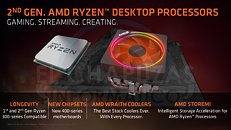- Joined
- Oct 9, 2007
- Messages
- 47,217 (7.55/day)
- Location
- Hyderabad, India
| System Name | RBMK-1000 |
|---|---|
| Processor | AMD Ryzen 7 5700G |
| Motherboard | ASUS ROG Strix B450-E Gaming |
| Cooling | DeepCool Gammax L240 V2 |
| Memory | 2x 8GB G.Skill Sniper X |
| Video Card(s) | Palit GeForce RTX 2080 SUPER GameRock |
| Storage | Western Digital Black NVMe 512GB |
| Display(s) | BenQ 1440p 60 Hz 27-inch |
| Case | Corsair Carbide 100R |
| Audio Device(s) | ASUS SupremeFX S1220A |
| Power Supply | Cooler Master MWE Gold 650W |
| Mouse | ASUS ROG Strix Impact |
| Keyboard | Gamdias Hermes E2 |
| Software | Windows 11 Pro |
Ahead of its launch product roadmap of AMD's next-generation performance-thru-enthusiast segment socket AM4 processors, was leaked to the web. It indicates that AMD could launch its next-generation Ryzen 2000-series "Pinnacle Ridge" processors with no more than four SKUs initially. These include the top-dog Ryzen 7 2700X, followed by the Ryzen 7 2700; the Ryzen 5 2600X, and the Ryzen 5 2600. Both Ryzen 7-series SKUs are 8-core/16-thread chips, while both Ryzen 5-series SKUs are 6-core/12-thread. There's also pricing for each of the four. The clock-speeds are also revealed below.
The Ryzen 7 2700X is being launched at a SEP of USD $369, and positioned against Intel Core i7-8700K. This is followed by the Ryzen 7 2700 being priced at $299, and fielded against Intel's multiplier-locked Core i7-8700. The Ryzen 5 2600X is, obviously, positioned against the Core i5-8600K, and priced at $249; while the Ryzen 5 2600 is priced at an attractive $199, and looks to disrupt several of Intel's Core i5 6-core SKUs around its price-point. Unlike many of Intel's SKUs, all AMD Ryzen chips feature unlocked multiplier, SMT, and a cooling solution. That's right, even the top-dog 2700X and 2600X include coolers, as opposed to their predecessors. The 2700X includes AMD's new Wraith Prism, while the 2600X and the other two SKUs include a Wraith Spire.




The Ryzen 7 2700X is the first socket AM4 SKU with 105W TDP. It features the highest clock speeds for the series, with 3.70 GHz nominal and 4.35 GHz boost clocks. The 2700 (non-X) is clocked at 3.20 GHz, with 4.10 GHz boost. The 2600X is clocked between 3.60~4.25 GHz, and the 2600 non-X between 3.40~3.90 GHz. One of the slides even confirms that the new AMD 400-series chipset still lacks PCI-Express gen 3.0 general-purpose lanes, leaving us to wonder what's the point behind that whole endeavor.
The slides confirm that the new chips are based on the new 12 nm silicon-fabrication process. There are some under the hood microarchitecture improvements, although the CPU core design is essentially the same (Zen). Improvements have been made to Precision Boost. The new Precision Boost 2 feature includes more fine-grained clock adjustments based on load and power. The new XFR 2.0 algorithm is even more temperature-aware in addition to power-draw aware, in serving up clock speeds beyond the boost frequency. The Precision Boost Overdrive mode pushes the boost clock to the absolute limits of the motherboard and CPU.



View at TechPowerUp Main Site
The Ryzen 7 2700X is being launched at a SEP of USD $369, and positioned against Intel Core i7-8700K. This is followed by the Ryzen 7 2700 being priced at $299, and fielded against Intel's multiplier-locked Core i7-8700. The Ryzen 5 2600X is, obviously, positioned against the Core i5-8600K, and priced at $249; while the Ryzen 5 2600 is priced at an attractive $199, and looks to disrupt several of Intel's Core i5 6-core SKUs around its price-point. Unlike many of Intel's SKUs, all AMD Ryzen chips feature unlocked multiplier, SMT, and a cooling solution. That's right, even the top-dog 2700X and 2600X include coolers, as opposed to their predecessors. The 2700X includes AMD's new Wraith Prism, while the 2600X and the other two SKUs include a Wraith Spire.




The Ryzen 7 2700X is the first socket AM4 SKU with 105W TDP. It features the highest clock speeds for the series, with 3.70 GHz nominal and 4.35 GHz boost clocks. The 2700 (non-X) is clocked at 3.20 GHz, with 4.10 GHz boost. The 2600X is clocked between 3.60~4.25 GHz, and the 2600 non-X between 3.40~3.90 GHz. One of the slides even confirms that the new AMD 400-series chipset still lacks PCI-Express gen 3.0 general-purpose lanes, leaving us to wonder what's the point behind that whole endeavor.
The slides confirm that the new chips are based on the new 12 nm silicon-fabrication process. There are some under the hood microarchitecture improvements, although the CPU core design is essentially the same (Zen). Improvements have been made to Precision Boost. The new Precision Boost 2 feature includes more fine-grained clock adjustments based on load and power. The new XFR 2.0 algorithm is even more temperature-aware in addition to power-draw aware, in serving up clock speeds beyond the boost frequency. The Precision Boost Overdrive mode pushes the boost clock to the absolute limits of the motherboard and CPU.



View at TechPowerUp Main Site





